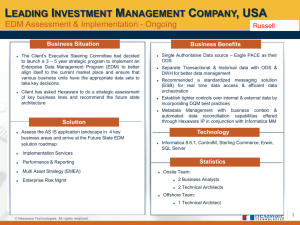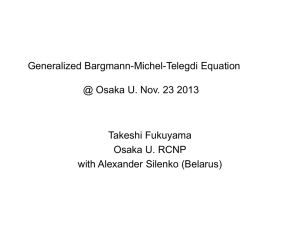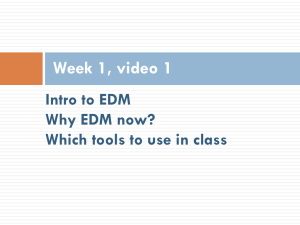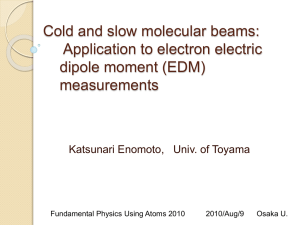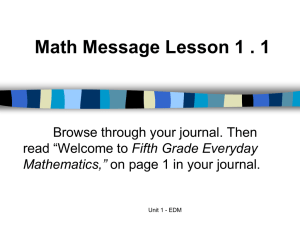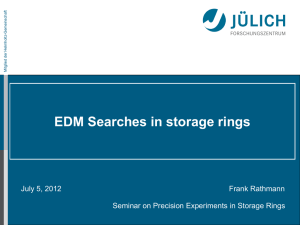Measurement of the electron`s electric dipole moment
advertisement
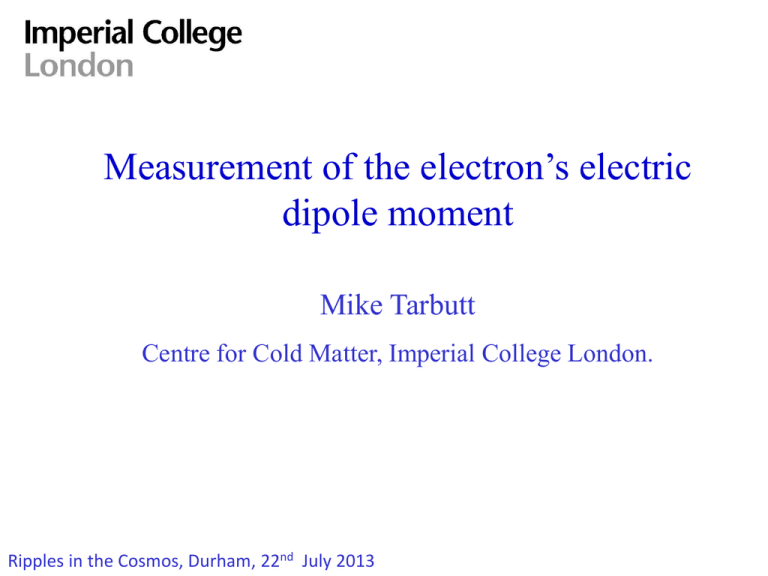
Measurement of the electron’s electric dipole moment Mike Tarbutt Centre for Cold Matter, Imperial College London. Ripples in the Cosmos, Durham, 22nd July 2013 + Spin Edm T + Either de = 0, or T T implies CP Spin Edm Predicted values for the electron edm de (e.cm) The electron’s electric dipole moment (EDM, de) 10-22 10-24 10-26 10-28 MSSM Multi Left Higgs Right Other SUSY 10-30 10-32 10-34 10-36 Insufficient CP Standard Model Measuring the EDM – spin precession B& E E Particle precessing in anti-parallel parallel a magnetic magnetic magnetic fieldand and electric electric fields fields Measure change in precession rate when electric field direction is reversed We use the valence electron in the YbF molecule We use a beam of YbF molecules Interaction energy = - de .Eeff Eeff = F P Effective field, Eeff (GV/cm) Structure dependent, ~ 10 (Z/80)3 GV/cm Polarization factor Simplified measurement scheme Pulsed YbF molecular beam 1st rf pulse B E hf±= 2mB ± 2 de Eeff 2nd rf pulse analyze spin direction Result (2011) 6194 measurements of the EDM, each derived from 4096 beam pulses Each measurement takes 6 minutes de = (-2.4 ± 5.7stat ± 1.5syst) × 10-28 e.cm | de | < 10.5 × 10-28 e.cm (90% confidence level) Nature 473, 493 (2011) Implications Excluded region Predicted values for the electron edm de (e.cm) 10-22 10-24 10-26 10-28 selectron g MSSM e Multi Left Higgs Right gaugino e Other SUSY 10-30 Mass of new particle 10-32 10-34 CP-violating phase For Ms= 200 GeV and qCP ≈1 => de ≈ 10-24 e.cm 10-36 Standard Model Ms > 4 TeV ? qCP < 10-3 ? Some other electron EDM experiments With molecules: • ThO at Harvard \ Yale - new result anticipated with very high sensitivity • WC at Michigan – in development With ions: • HfF+ at JILA – trapped ion with rotating E & B fields, very long coherence times, being developed With atoms: • Trapped ultracold Cs at Penn State and U. Texas, being developed • Trapped ultracold Fr at Tohoku / Osaka, being developed With solids: • Gadolinium Garnets at LANL and Amherst – lots of electrons, but difficult to control systematic effects Particle EDMs - historic and present limits s [d] (e.cm) d(m) 2×10-19 neutron: electron: 10-20 10-22 d(p) 6×10- 23 10-24 10-26 d(n) 3×10d(e) 10-28 1960 1970 1980 1990 2000 2010 2020 2030 Year 26 1×1027 CMSSM constraints from EDM measurements tan b = 3, MSUSY=500GeV M. Le Dall and A. Ritz, Hyperfine Interactions 214, 87 (2013) Future experiments with YbF molecules Upgrades to existing experiment – x10 improvement (in progress) Molecular fountain of ultracold YbF molecules (under development) x1000 improvement Thanks... Dhiren Kara Jack Devlin Joe Smallman Jony Hudson Ben Sauer Ed Hinds The YbF EDM experiment – schematic J. J. Hudson, D. M. Kara, I. J. Smallman, B. E. Sauer, M. R. Tarbutt & E. A. Hinds, Nature 473, 493 (2011) Using atoms & molecules to measure de For a free electron in an applied field E, expect an interaction energy -de.E N.B. Analogous to interaction of magnetic dipole moment with a magnetic field, -m . B E Interaction energy = - de .Eeff Eeff = F P Electric Field Atom / Molecule Structure dependent, ~ 10 (Z/80)3 GV/cm Polarization factor For more details, see E. A. Hinds, Physica Scripta T70, 34 (1997) Ground state YbF E MF -1 0 +1 de Eeff F=1 -de Eeff 170 MHz X 2S+ (n = 0, N = 0) F=0 Electric Field We measure the splitting 2deEeff between the MF = +1 and MF = -1 levels Measurement scheme – a spin interferometer PMT B HV+ rf pulse Pulsed YbF beam Probe A-X Q(0) F=0 HVPump A-X Q(0) F=1 F=1 F=0 Measuring the edm with the interferometer Signal α cos2 [f/2] = cos2 [(mB B – de Eeff ) T / ћ] Counts B E Modulate everything ±B ±rf1f ±rf1a ±rff ±E ±B spin interferometer ±rf2f ±rf2a ±laser f 9 switches: 512 possible correlations The EDM is the signal correlated with the sign of E.B We study all the other 511 correlations in detail Signal Correcting a systematic error F=0 rf F=0 Stark-shifted hyperfine interval Stark-shifted hyperfine interval rf F=1 E E F=1 rf detuning Imperfect E-reversal phase shift: ~100 nrad/Hz Changes detuning via Stark shift Phase correlated with E-direction Correction to EDM: (5.5 ± 1.5) × 10-28 e.cm Systematic uncertainties Effect Systematic uncertainty (10-28 e.cm) Electric field asymmetry 1.1 Electric potential asymmetry 0.1 Residual RF1 correlation 1.0 Geometric phase 0.03 Leakage currents 0.2 Shield magnetization 0.25 Motional magnetic field 0.0005 How to do better The statistical uncertainty scales as: Total number of participating molecules 1 N 1 T 1 E Electric field Coherence time Cryogenic source of YbF Produce YbF molecules by ablation of Yb/AlF3 target into a cold helium buffer gas Helium is pumped away using charcoal cryo-sorbs Produces intense, cold, slow-moving beams Cold, slow beam of YbF molecules Rotational temperature: 4 ± 1 K Translational temperature: 4 ± 1 K Speed vs helium flow Molecules / steradian / pulse Flux vs helium flow Flow rate / sccm Magnetic guide Permanent magnets in octupole geometry, depth of 0.6 T Separates YbF molecules from helium beam Guides 6.5% of the distribution exiting the source Laser cooling A2 ½ v’= 0 0.3% 92.8% X2S(N =1) 552 nm 6.9% 584 nm 568 nm v’’=2 v’’=1 v’’= 0 Laser Laser Excited state Laser cooling is the key step!! Spontaneous emission Absorption Ground state Simulations for YbF in an optical molasses 6 beams each containing 12 frequencies from 3 separate lasers – 750 mW total Sensitivity of an EDM fountain experiment Quantity Value How determined? Molecules in cell 1013 Measured by us Extraction efficiency 0.5 % Measured by Doyle group Fraction in relevant rotational state 24 % Boltzmann distribution Fraction accepted by guide 6.5 % Magnetic guide simulation Fraction cooled in molasses 0.76 % Molasses simulation Rotational state transfer efficiency 100 % Pi-pulse Fraction though fountain 7.5 % Free-expansion at 185mK Detection efficiency 100 % Fluorescence on closed transition Coherence time 0.25 s By design Repetition rate 2 Hz By design EDM sensitivity in 8 hours 6 x 10-31 e.cm Statistical sensitivity

